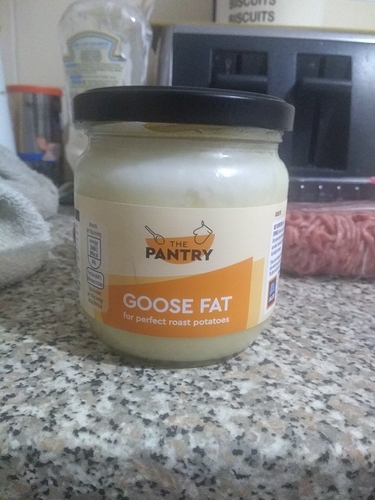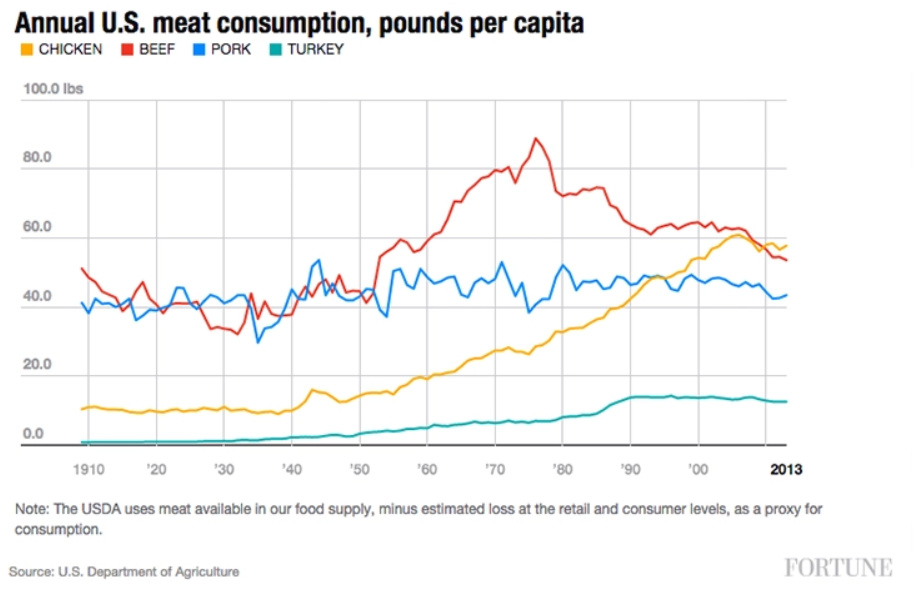I decided to try goose fat recently & it was absolutely amazing. Anyone else tried goose fat? Went well with eggs.
Goose fat is amazing
I’ve made my own the few times I’ve had goose. (It’s an expensive meat.) I thought it was great when I’ve had it.
Not sure of the PUFA content, though.
Funnily enough I’ve never actually had goose, only the fat. Not sure about the pufa either, I’m just gonna place it the same league as chicken for now unless I see evidence of the contrary.
I love goose, though it’s expensive and you don’t get much meat for the price. Doubly expensive, I guess.
But it’s so fatty that if you bake it, you get a ton of fat. Similar to duck. Then, you can just boil the water away and get the fat.
According to the U.S. Department of Agriculture:
| In 100 g of goose fat: | ||
|---|---|---|
| Total saturated fat | 27.7 | g |
| 14:0 | 0.5 | g |
| 16:0 | 20.7 | g |
| 18:0 | 6.1 | g |
| Total monounsaturated | 56.7 | g |
| 16:1 | 2.8 | g |
| 18:1 | 53.5 | g |
| 20:1 | 0.1 | g |
| Total polyunsaturated | 11 | g |
| 18:2 | 9.8 | g |
| 18:3 | 0.5 | g |
| Cholesterol | 100 | mg |
Long ago, a friend’s family used to put it on toast. I tried it once, and it was good. I’ve never seen it for sale, and I doubt I could afford it anyway. I’ll probably never have it again!
I’m sure it’s great stuff! But like beluga caviar won’t be on my plate any time soon. 
If the geese are reared on grass (as they should be), then the fat is a good shout. I prefer lard because, to me, it has a superior taste to dripping (tallow) but I know some carnivores avoid it due to PUFA concerns.
@PaulL Well, depending on your thoughts about linoleic acid (18:2), that can be okay, somewhat high, or deadly. 
The problem is that since birds are what they eat, and we don’t know what they ate, it’s hard to get an exact number. We get chickens from a farm, and I have no idea what the PUFA content is. Higher or lower than store-bought? Not sure, though they taste way better than store-bought
@Jamesbrawn007 It depends on the carnivore. Amber O’Hearn thinks this stuff doesn’t matter for carnivores. I can’t figure out whether it does. For instance, there’s an idea that if you eat greater than a very low percentage of calories (2% or so) of PUFAs and particularly EVIL linoleic acid, you’ll be hungry But if I eat chicken, I can’t tell that I’m any hungrier than eating, say, beef. The same occurs with fish (high in PUFA, though O3 too) or any other relatively-high PUFA meat.
But let’s say I ate nothing but beef or nothing but chicken, at two different times, and tried to compare the effects. Let’s say you do get hungrier from chicken. Is that from PUFAs? Or a difference in nutrition/protein between the two? Or both? It’ s impossible to say.
As for cooking fats, I make my own tallow and use it a lot. I got frightened away from lard, goose fat, duck fat, as those you can’t tell how many PUFAs are actually in them. I’d say liquid is bad, but MUFAs can also be liquid at room temp. (Of course, this depends on your thoughts about MUFAs, which some dislike.)
And, I’ve been rethinking the whole PUFAs are deadly concept. While there may be valid reasons to avoid them, I’m not sure PUFAs in meat are as terrible as we’ve been led to believe.
I think it is certainly at the lower end of the worry scale. Paul Saladino claims he has seen people who’s weight loss had stalled suddenly improve after switching out pork and chicken. The other factor is cuts; If you are eating leaner cuts then the PUFA issue should be minimal. Personally, from what I understand about animal welfare here in the UK, PUFAs is not a concern, especially if the animals are free range, forage fed, etc, which is becoming more popular (hence affordable) in supermarkets these days.
I know, this is still an active area of discussion in the carnivore group (though is Saladino still a carnivore and part of that group?).
But again, if one changes from pork and chicken to something else (most likely beef), how can one tell if the weight loss is due to PUFAs or nutrition or more protein or protein/fat ratios, or a combination of these?
Believe me, for a long time I believed PUFAs, even in meat, were the spawn of Satan. But after finding success again eating higher protein, lower fat keto, I’m wondering about this. In diet, you can’t really change one thing. You can’t really change only PUFA content for instance. You change multiple items.
I’ve switched to a lot of beef a while back, at least a year or more now. I tend to eat a lot of leaner cuts of beef, mainly because they are cheaper. I bet if I was to compare the nutrition of the cuts of beef I’m eating and say chicken or pork (though I also typically limit myself to lean cuts of pork), the nutritional content of beef would be way better (edit:or different). Maybe a body can tell the food is more nutritious and therefore you eat less? Or it could be the PUFAs. Who knows? It’s too hard to tell.
There are certain PUFA’s that we evolved eating, and I’m sure those are fine. The problem, at least as I understand it from Nina Teicholz’s book and lectures, is that it is the PUFA’s in industrial seed oils that are the problem, because (a) most of them were not part of our ancestors’ food supply as we evolved, and (b) they break down under heat into other compounds, which are also not part of our evolutionary history, and some of which are actually toxic.
The problem with getting any research done into this is that we already “know” that (a) saturated fat will give us heart attacks and diabetes, and (b) all PUFA’s are magically healthful substances that will lower our cholesterol, straighten our teeth, and keep us forever young.
The problem is many-fold. Chickens and pigs raised naturally, such as (for pigs) scraps from low-PUFA foods, will have low PUFA. Now, they can have high PUFA because “vegetarian diets” are advertised as being good for them. But those diets can be high PUFA, which means what we eat is higher PUFA.
And, our consumption of chicken as exploded while our consumption of beef has plummeted. Like this for instance:
If chickens (and pork) are high PUFA now, and they weren’t before, this could mean we’re getting relatively high PUFA even being keto. Or possibly carnivore.
Keto is a bit easier to see as possibly being high PUFA, as you can add high-PUFA nuts, bacon, olive oil (not high in PUFA but another source), chicken, pork and its fat (we’re supposed to eat “high fat”, aren’t we?), avocados (again not high PUFA but another source), etc.
Carnivores tend not to eat a lot of bacon for some reason. Most I see rely heavily on beef.
And when you consider that “high” PUFA is 2% of calories by some calculations, that’s not much. That’s only 60 calories in 3,000 calories. I calculated 2 tablespoons of olive oil (that miracle elixir) has about 20 calories of linoleic acid, so you’re a third of the way there with a small salad. And if you eat 1,500 calories a day, you’re 2/3 of the way through your PUFA limit.
Calculations like this are why I’ve been rethinking my bias against PUFAs. I can’t see anyone not becoming overweight with those limits, yet there are many who likely surpass those limits and aren’t overweight. Why?
I agree completely with this. I also think it’s consumption of seed oil PUFAs that is the primary problem, not consumption of birds and/or pigs per se. I think our ancestors ate plenty of birds and omnivorous ungulates. That said, I also agree with @ctviggen that eating birds and pigs that have been fed diets high in seed oils is probably not a good idea. Those of us who don’t raise chickens and pigs have to read labels and do a bit of research to find sources that don’t use common commercial feeds. For example.
PS: I eat macadamia nuts regularly, and occasionally (like once or twice a year) walnuts and Brazil nuts. Macs contain 12.1g SFA, 58.9g MUFA, and 1.5g PUFA per 100 grams. And 5.2 grams net carbs per 100 grams. I don’t know about other nuts, but macs look pretty good to me. Source.
I’ve only had it in France, yes Dordogne (Périgord) that my beloved foie gras comes from. I almost became addicted to potatoes fried in it. But anything cooked in it was heavenly. This was pre keto period of my life.
This is one reason why I think the PUFA idea might go awry. I can easily, and I mean EASILY, overeat macadamia nuts. So much so that I don’t eat them. Yet they are high sat fat nuts. They should fill me up, if the theory is that sat fat causes satiety, but don’t.
I’ve even been thinking of getting Brazil nuts, as they are high in selenium. Found chocolate covered ones at Costco, but those are the only ones I’ve seen. I didn’t buy them due to their being high carb.
We used to get a Brazil nut in the toe of our stockings, every Christmas. I won’t offend you by repeating what they were called, back then. Mom also found a nut mix, available around the holidays, that included them. As I recall, they were a pain to crack open, and the nutmeat was very difficult to separate from the shell.
Meat, butter, and goose fat all contain selenium, btw. We don’t need all that much.


